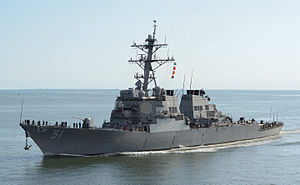
The Arleigh Burke class of guided missile destroyers (DDGs) is the United States Navy's first class of destroyer built around the Aegis Combat System and the SPY-1D multifunction passive electronically scanned array radar. The class is named for Admiral Arleigh Burke, the most famous American destroyer officer of World War II, and later Chief of Naval Operations. The class leader, USSÂ Arleigh Burke, was commissioned during Admiral Burke's lifetime.
These warships were designed as multimission destroyers Besides the 62 vessels of this class (comprising 21 of Flight I, 7 of Flight II and 34 of Flight IIA) in service by 2016, up to a further 42 (of Flight III) have been envisaged.
With an overall length of 505 to 509 feet (154 to 155Â m), displacement ranging from 8,315 to 9,200 tons, and weaponry including over 90 missiles, the Arleigh Burke class are larger and more heavily armed than most previous ships classified as guided missile cruisers.
The ships of the Arleigh Burke class are among the largest destroyers built in the United States. Only the Spruance, Kidd (563 feet (172Â m)) and Zumwalt classes (600 feet (180Â m)) were longer. The larger Ticonderoga-class ships were constructed on Spruance-class hull forms, but are designated as cruisers due to their radically different mission and weapons systems than the Spruance and Kidd-class destroyers. The Arleigh Burke class, on the other hand, were designed with a new, large, water-plane area-hull form characterized by a wide flaring bow which significantly improves sea-keeping ability. The hull form is designed to permit high speed in high sea states.